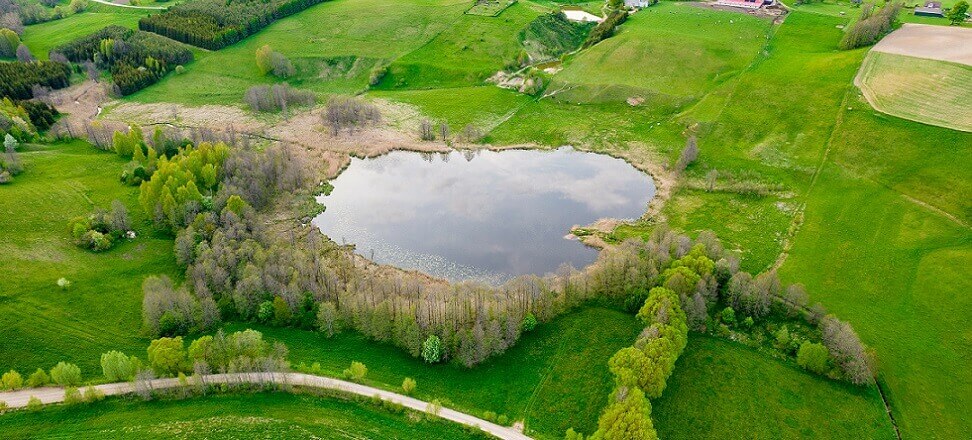Again about climate change…
Observed climate change is forcing measures to both prevent its further progress and adapt to current conditions.
The consequences of climate change are likely to have a significant impact on agricultural production in the future, mainly on crop yields. In addition, forecasts indicate that by 2050. The water needs of plants will increase by approx. 30%. If preventive measures are not taken now, and the suppositions become reality, a noticeable increase in yield losses can be expected.
Thus, the situation we are experiencing today should be the impetus for immediate action to reduce the negative effects of global warming.
What is retention?
It is understood that retention (Latin retentio – retention ) is the ability to retain and store water. Water retention depends on both natural factors (soil type, vegetation cover, slope, land depressions, etc.) and anthropogenic factors (artificial water reservoirs, land reclamation, land use and development).
Types of retention
The following types of retention can be distinguished:
- Surface – in watercourses, standing water, glaciers and snow cover (it is shaped by the retention of water from precipitation on the surface of plants, in the forest stand, in irregularities in the terrain, in reservoirs and watercourses; in the form of snow and glaciers; in wetlands);
- underground (water is retained in the zone located between the soil surface and the groundwater table and in the rock layer);
- Soil (is shaped by water storage in the aeration zone of the soil profile);
- Landscape (related to the basin’s terrain, land use and development; forests and grasslands have the greatest capacity for this type of retention).
Retention in rural areas
For decades, technical measures to collect or drain water have been implemented at different rates and to different extents. In areas used for agriculture, these are mainly land reclamation and small reservoirs.
We also observe that despite the efforts and high financial outlays to date for the above-mentioned measures, we are increasingly experiencing water shortages and droughts, but also floods and flooding after heavy rains. These phenomena generate heavy losses for agriculture, especially for crop production.
The worrisome situation makes it indispensable to increasingly implement non-technical measures aimed at water retention.
For agriculture, it is important to retain water in the soil, especially when the distribution of precipitation is uneven and there are periods of water shortages or droughts. The soil has the capacity to retain from 50 mm to more than 200 mm of plant-available water. The amount of water retained is determined by the structure of the soils, the amount of free spaces present in the soil profile, the abundance of organic matter and the mechanical composition. Farmers should therefore pay attention to adapting tillage techniques to the soil type and modify them according to prevailing or forecast weather conditions.
An important issue related to the availability of water in the soil is the sealing of the topsoil as a result of the use of heavy field machinery, for example. This prevents water from infiltrating deep into the soil profile. Therefore, it is important to use appropriate agrotechnical treatments. It is also worth remembering that soil compaction is prevented by, for example, deepening, cultivation of plants with a stilt root system and liming.
Retention through non-technical activities
Rationalizing water use in agriculture involves both using water in a way that does not cause unnecessary losses, using resource-efficient techniques and technologies in production, reusing water, and adapting the type of crops and production system to the prevailing climatic conditions.
Treatments to retain water in the soil and reduce the use for crop production of that already stored are:
- Conservation tillage (no-till) – improves water infiltration and capillary rise and reduces evaporation;
- Quick stubble plowing after harvesting – stops water evaporation;
- Use of intercrops – reduces water loss from the soil, reduces the risk of water erosion;
- Mulch of crop residues, catch crops, which works well in simplified farming systems – improves water absorption, the use of sowing in mulch reduces evaporation and increases field water capacity;
- plowing straw – shredded straw mixed with soil reduces evaporation;
- Strip tillage – improves plant access to water, which more effectively penetrates the roots; improves water circulation;
- Crop rotation – improves soil properties, including the potential water storage capacity of the soil profile;
- Leaving crop residues on the field -reduces the risk of water erosion;
- Aggregation of tillage operations – reducing soil compaction and, consequently, increasing water holding capacity in the soil profile;
- Preventing the formation of plow soles and preventing the compacting of the subsoil layer – greater ability to retain water in the soil profile;
- Removal of deep-rooting weeds (e.g., in stubble fields, in wide-row crops) – helps prevent water loss from the soil profile;
- Abandoning spring crops in favor of winter crops – they use water from winter precipitation more efficiently;
- direct seeding, without prior post-harvest tillage – allows the soil to retain moisture that would otherwise evaporate after each treatment;
- Creation and maintenance of mid-field trees and shrubs – reduces losses due to reduced evaporation from the soil, slows the rate of snow melt in spring, reduces the daily amplitude of air temperature, retains rainwater in the tree crowns, increases air humidity in the ground layer, reduces water erosion;
- The use of natural fertilizers, primarily manure – increases the proportion of organic matter in the soil, and consequently contributes to water retention in the profile;
- Pre-sowing and post-sowing administration of minerals responsible for water management of plants;
- Growing species and varieties with a shorter growing season and lower water needs;
- Plant rotation adapted to soil and climate conditions;
- Appropriate selection of crop varieties;
- appropriate timing of agrotechnical treatments and crop protection against weeds, diseases and pests.
Agrotechnical methods that promote retention are:
- Increasing retention by improving soil structure;
- An increase in the humus content of the soil – each 1% of organic matter can store an additional 150m3 of water per hectare;
- Reduce surface runoff and increase groundwater recharge through the use of anti-erosion treatments and mid-field strips, and the cultivation of catch crops;
- Reducing evapotranspiration through appropriate plant selection and reducing evaporation from the soil surface;
- Creation of ecological land, including restoration of wetlands, ponds, floodplains, etc..;
- The reuse of treated wastewater, the so-called. “water reuse.
Planning methods that aim to shape spatial order in such a way as to slow down the runoff of rainwater and snowmelt are:
- Shaping the proper layout of arable fields, grasslands, forests;
- Creation of vegetated shelterbelts (shrubs, trees);
- creation of sodded strips of surface water runoff, along with structures that inhibit this runoff;
- creation of ecological uses;
- Proper design of communications infrastructure.
EU funds support non-technical water retention measures in rural areas.
Within the framework of the Strategic Plan of the Common Agricultural Policy, the ecoscheme “Water Retention on Permanent Grasslands” was proposed.
The aim of the ecoscheme is to promote water retention to improve water management, as well as to reduce carbon dioxide emissions into the atmosphere (by reducing the decomposition of organic matter). Its implementation is important because of:
- unfavorable changes in the amount and distribution of precipitation, resulting in further deterioration of water resources necessary for agricultural production;
- Periodic deficits in precipitation, low potential for water accumulation in the soil;
- A relatively high proportion of permanent grassland;
- a large share in rural areas of NATURA 2000 areas, which are natural and semi-natural ecosystems dependent on agriculture and forestry;
- the need to protect hydrogenic habitats, especially those predestined for retention functions, whose natural condition depends on the presence of water;
- Water retention, which contributes to halting and reversing biodiversity loss, enhancing ecosystem services, and protecting habitats and landscapes.
Funding will be awarded to farmers who make their permanent grassland available for water retention purposes. A prerequisite is that they be located in areas where flooding actually occurred during the growing season of a given year.

 Polski
Polski






